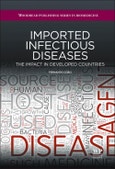The increase of immigrant population in developed countries (mainly in Europe and North America) together with an important increase of international travel worldwide are the two most important causes that have contributed to the introduction and diagnosis of imported/tropical infectious diseases in these countries. These factors have had an important impact in developed countries in both social and economic aspects. Imported Infectious Diseases focuses not only on describing the infections, but also in evaluating the current epidemiology, the economic and social impact and the possibility to apply immunization measures and vaccines. The main purpose of this book is to give an overview of the current most important and frequent imported infectious diseases in developed countries. The first chapter informs about the medical services that are being offered to the immigrants in the main developed countries depending on the legal situation. Following chapters describe the main surveillance systems for these kinds of diseases, mainly in Europe and North America. Finally, remaining chapters contain sections on epidemiology, pathogenesis, clinical features, diagnosis, treatment and prevention.
Please Note: This is an On Demand product, delivery may take up to 11 working days after payment has been received.
Table of Contents
- List of figures
- List of tables
- Acknowledgements
- Preface
- About the author
- 1: Introduction
- Abstract
- 1.1 The real problem of the immigration phenomenon
- 1.2 Immigration health costs in developed countries
- 1.3 Health assistance in immigrants: comparison of several countries
- 1.4 Impact of immigration on infectious diseases in developed countries
- 2: Epidemiology of infectious diseases in immigrants
- Abstract
- 2.1 Importance of immigration in the epidemiology of infectious diseases
- 2.2 Immigration patterns and infectious diseases
- 2.3 Current epidemiological data of the main imported infectious diseases in immigrants
- 2.4 Implications for public health research and intervention policies
- 3: Surveillance systems for tropical infectious diseases in developed countries
- Abstract
- 3.1 Definition of surveillance
- 3.2 Local and regional surveillance systems
- 3.3 National Public Health Institutes
- 3.4 International public health surveillance systems
- 3.5 Information for disease prevention and control
- 4: Febrile syndrome in immigrants and travellers
- Abstract
- 4.1 Introduction
- 4.2 Assessment of febrile syndrome in immigrants and returned travellers
- 4.3 Standardised diagnosis protocols
- 5: Diarrhoea syndrome
- Abstract
- 5.1 Approach to acute diarrhoea in developing countries
- 5.2 Traveller's diarrhoea
- 6: Current status of malaria
- Abstract
- 6.1 Disease and pathophysiology
- 6.2 Epidemiology of imported malaria
- 6.3 Biology and ecology of malaria
- 6.4 Clinical features of malaria
- 6.5 Diagnostic procedures
- 6.6 Prevention and prophylaxis: development of a malaria vaccine
- 6.7 Treatment of malaria
- 7: Filariasis
- Abstract
- 7.1 Definition
- 7.2 Life cycle
- 7.3 Lymphatic filariasis
- 7.4 Onchocerciasis (river blindness)
- 7.5 Loiasis
- 7.6 Mansonellosis
- 8: Schistosomiasis (bilharziasis)
- Abstract
- 8.1 The parasite and the disease
- 8.2 Epidemiology
- 8.3 Pathogenesis
- 8.4 Clinical features
- 8.5 Diagnosis
- 8.6 Treatment
- 9: Strongyloidiasis
- Abstract
- 9.1 Definition
- 9.2 Epidemiology
- 9.3 Clinical features
- 9.4 Risk factors for hyperinfection and severe disease
- 9.5 Diagnosis
- 9.6 Treatment and monitoring
- 9.7 Prevention
- 10: Trypanosomiasis
- Abstract
- 10.1 General description
- 10.2 African trypanosomiasis
- 10.3 American trypanosomiasis
- 11: Taeniasis and neurocysticercosis
- Abstract
- 11.1 Taeniasis
- 11.2 Neurocysticercosis
- 12: HIV infection
- Abstract
- 12.1 Initial outbreak
- 12.2 Current epidemiological status and mode of transmission
- 12.3 Viral structure and pathogenesis
- 12.4 Clinical manifestations
- 12.5 Diagnosis
- 12.6 Drug treatment
- 12.7 Prevention of HIV transmission
- 13: Syphilis
- Abstract
- 13.1 Aetiology
- 13.2 Epidemiology
- 13.3 Natural history and clinical manifestations
- 13.4 Laboratory diagnosis
- 13.5 Treatment of syphilis
- 13.6 Follow-up examinations
- 14: Tuberculosis: the problem of multiresistance
- Abstract
- 14.1 Definition and microbiology
- 14.2 Current epidemiology
- 14.3 Pathogenesis
- 14.4 Clinical manifestations
- 14.5 Diagnosis
- 14.6 Prevention and control
- 14.7 Treatment
- 15: Viral hepatitis
- Abstract
- 15.1 Introduction: the global problem of infectious hepatitis
- 15.2 Hepatitis A virus (HAV)
- 15.3 Hepatitis B virus (HBV)
- 15.4 Hepatitis C virus (HCV)
- 16: Leishmaniasis
- Abstract
- 16.1 Definition
- 16.2 Visceral leishmaniasis
- 16.3 Cutaneous leishmaniasis
- 17: Viral haemorrhagic fevers
- Abstract
- 17.1 Definition and overall epidemiology
- 17.2 Yellow fever
- 17.3 Lassa fever
- 17.4 Marburg haemorrhagic fever
- 17.5 Ebola haemorrhagic fever
- 17.6 Crimean-Congo haemorrhagic fever
- 17.7 Dengue
- 17.8 Rift Valley fever
- 17.9 Laboratory diagnosis
- 17.10 Prevention measures and control
- 17.11 Antiviral treatment
- 18: Arthropod-borne viruses affecting the central nervous system
- Abstract
- 18.1 Definition and epidemiology
- 18.2 General diagnosis
- 18.3 Clinically relevant arthropod-borne viruses
- 19: Prophylaxis, immunisation and vaccination
- Abstract
- 19.1 General considerations
- 19.2 Current status of selective vaccines
- Index








